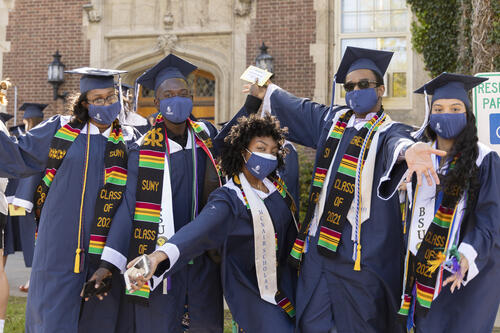
For nearly 40 years, one of the hallmarks of the SUNY Geneseo curriculum has been its humanities sequence. Thousands of students have taken the two courses designed to garner a deeper understanding of the humanistic transition, emphasizing the search for moral, social, and political alternatives and meaning as embodied in the institutions, culture, and literature. In the fall of 2019, a new option for completing the humanities requirement emerged, a result of a big idea and a $3,000 Innovation Course Development grant from the Modern Language Association.
Black Humanities (HUMN 222), now offered every semester, focuses on an alternate narrative of American history. Following the framework set by Nikole Hannah-Jones’ 1619 project, the course asks students to consider the possibility that the origin of America can be traced to 1619, the year the first enslaved Africans arrived in what would later become the United States.
Rather than offering a chronological history of specific regions, the course focuses on the interconnections of peoples and belief systems throughout Europe, Africa, and the Americas.
“Our course design retains the texts at the heart of the traditional Humanities curriculum and puts them into dialogue with this alternate narrative,” said Maria Helena Lima, professor of English, director of comparative literature, and interim Black Studies coordinator, who designed the course and is currently teaching it. “We explore how African diasporic ideas have resisted and/or re-imagined more familiar narratives of Western Civilization.
“As it’s brand new, it’s constantly evolving, so it’s enabling students to journey with the professor,” she continued. “There was ‘blood on the floor’ many times but my inaugural class of students was fantastic!”
HUMN 222 has launched a more culturally-responsive curriculum at SUNY Geneseo. It teaches digital humanities skills, and emphasizes local history, too, such as the Genesee Valley’s long history of social activism around emancipation. It also showcases under-represented ideas emerging from Black authors and contexts.
“This course is more than just an alternative to the traditional Humanities requirement,” said Lytton Smith, director of the Center for Integrative Learning, associate professor of English and creative writing, and member of the Black studies faculty, who wrote the grant to fund the course. “Such teaching aligns with the college’s efforts to become an antiracist institution by placing an emphasis on antiracism at the core of the general education curriculum.”
Smith added that it’s vitally important for Black and Brown students to have an opportunity to engage with works that represent and think through the experiences of their communities. It’s equally important for White students to also educate themselves on how they fit into these new-to-them narratives. Lima and Smith are hopeful that HUMN 222 will help attract and retain BIPOC students, supporting them as they find meaning in a college curriculum that underscores the relevance of their ancestors’ history.
“Students are able to choose a project based on their major,” explained Lima. “For example, biology students might explore scientific racism, and education students might examine racism in the K through 12 classroom.”
Smith explained that the original grant obtained to fund the development of the course is also extending this work to other courses and instructors. “HUMN instructors have had the opportunity to attend workshops focused on topics, such as how to talk about familiar texts within this new context of Black experience. We also have offered professional development workshops focused on the digital tools available to explore these narratives through visualization platforms,” he said.
The course and related professional development are bringing faculty and students together to explore multiple narratives and come to center on what is true about American history. A long time HUMN instructor, Distinguished Teaching Professor Ronald Herzman, explained the endeavor when he stated in his farewell lecture, “Inquiry is a communal activity into the nature of the real.” As the community of faculty and student scholars grows, as Lima and Smith emphasize, so, too, will anti-racism efforts and initiatives.